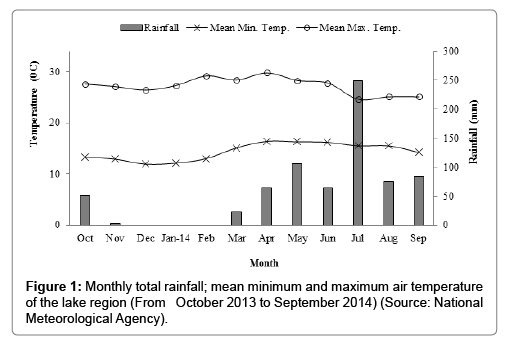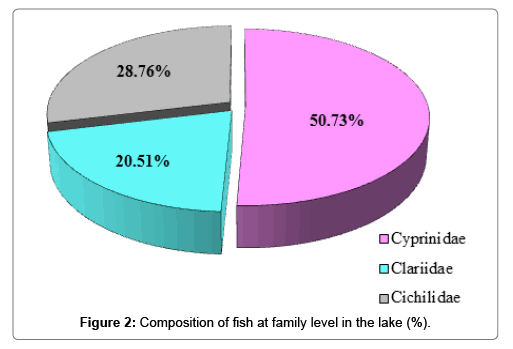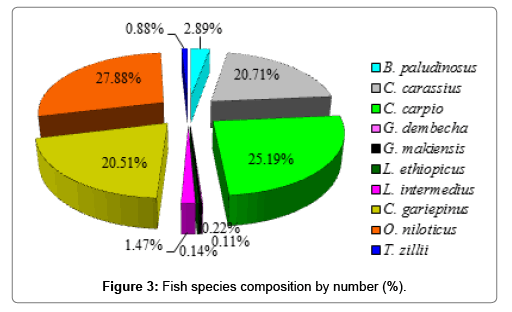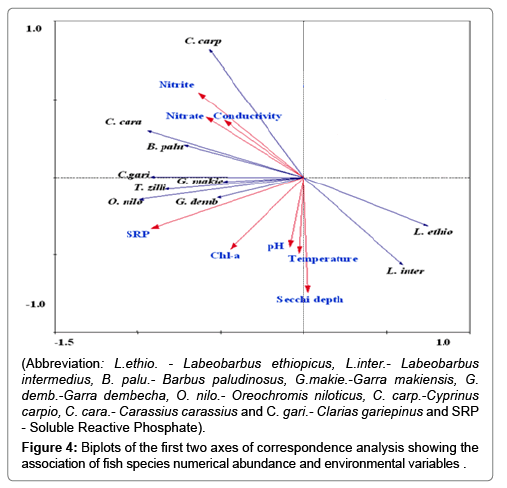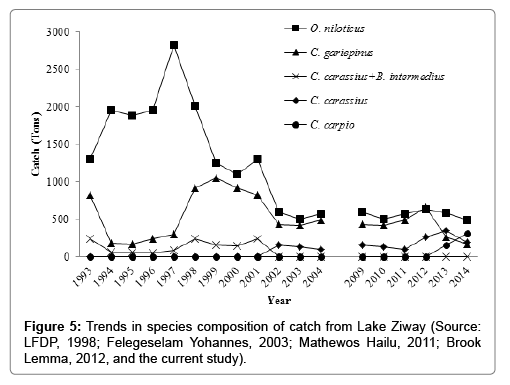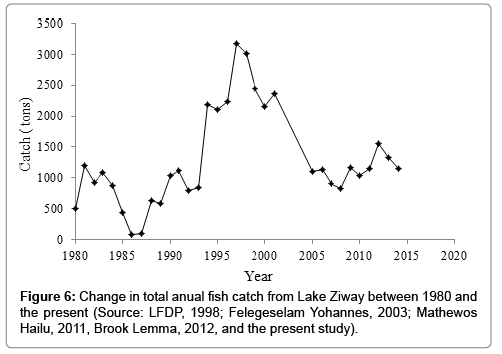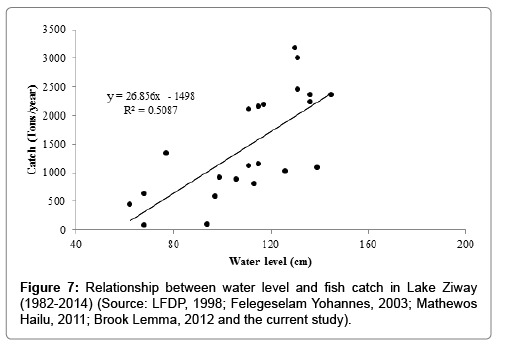Changes in Fish Diversity and Fisheries in Ziway-Shala Basin: The Case of Lake Ziway, Ethiopia
Received: 09-Feb-2018 / Accepted Date: 27-Feb-2018 / Published Date: 03-Mar-2018 DOI: 10.4172/2332-2608.1000263
Abstract
Lake Ziway is an economically important lake in the country. However, the physico-chemical parameters of the lake seem to be threatened by anthropogenic and climatic factors, which in turn affect biotic factors as reflected in fish catch. A study was made to assess the status and trends of fish diversity and fishery during October 2012 to September 2014 in Lake Ziway. Ten fish species were identified with low species diversity for the lake (H′ value of 1.67). The composition of the fishes has undergone some changes as compared to the last few decades.
Keywords: Abundance; Catch; Fish composition; Physico-chemical factors; Lake Ziway
Introduction
Ethiopia has a number of lakes and rivers with substantial quantity of fish stocks. Many artificial water bodies have also been stocked with fish for fishery. Most of the lakes are located in the Ethiopian Rift Valley, which is part of the Great East African Rift Valley system. Lake Ziway is one of the lakes in the rift valley used for multiple purposes like irrigation, fishing, domestic water supply, transportation, recreation, supply of fresh water to Lake Abijata through the out flowing Bulbula River and most recently indoor flower farming.
There are seven indigenous fish species in Lake Ziway comprising Barbus paludinosus, Garra dembecha, Garra makiensis, Labeobarbus ethiopicus, Labeobarbus intermedius, Labeobarbus microterolepis and Oreochromis niloticus [1,2]. Of these, L. ethiopicus, G. makiensis and L. microterolepis were reported as endemic to the lake [1,2]. The lake also harbors five exotic fish species (Tilapia zillii, Cyprinus carpio, Carassius carassius and Carassius auratus) which were introduced to enhance its production, and Clarias gariepinus that slipped into the lake accidentally [1,3]. Therefore, the lake has several important fish species for fisheries. The fish yield potential of the lake estimated from 3000 to 6680 tons per year [4] and the fisheries production has been the second largest from the Rift Valley lakes, which accounted for 3180 tons, next to Lake Chamo that produced 4500 tons per year [5]. However, according to Tigabu [6], there was a continuous decline in the annual catch of some fish species like O. niloticus from the lake since 1997, but on the other hand an increase of C. gariepinus was observed in the fishermen catches since 2010 [7]. In the same way, very recently increase in the catches of C. carpio was recorded [8].
For all these there are several evidences in the lake, such as decline in phytoplankton biomass [9], increase in dominance of toxin-producing blue-green algae [10], imbalance between water inflow and outflow [11] and decreased lake water volume [12]. Also commercial fish production in the lake was intensified through the support acquired from Lake Fisheries Development Project and onwards, the fish stocks of the lake have declined for a variety of reasons.
Although several studies were conducted on Lake Ziway on various aspects, the changes on the lake are fast and hence the information on the lake gets obsolete quickly. Therefore, regular updating, monitoring and control are essential and this study becomes important and relevant for better management and sustainable use of the resources. Therefore, this paper attempts to assess the variations in some physico-chemical factors that influence the fish community structure; to update the species composition, distribution and relative abundance of the fishes; and finally to assess the trends of the commercial catch in relation to some environmental factors that were recorded earlier.
Methodologies
Location of the study area
Lake Ziway belongs to the Central Ethiopian Rift. On the average, the lake is located at an elevation of 1650 meter above sea level, 7°89'- 8°05' N latitude and 38°72' - 38°92' E longitude located at about 163 km south of Addis Ababa. The lake is shallow and has an open water area of 434 km2, shoreline length of 137 km and an average depth of 2.5 m [13]. The maximum length and width of the lake is 32 km and 20 km, respectively [14].
The lake region in general is arid and even during the rainy seasons dry periods of several weeks are common. According to the data obtained from National Meteorological Agency, during the study period the mean monthly minimum air temperature ranged from 11.9 to 16.4°C, while the maximum mean monthly air temperature varied from 24.6 to 29.8°C (Figure 1). Monthly total rainfall also varied from 1.9 mm (November 2013) and 249 mm (July 2014) (Figure 1).
Site selection
To assess the variation in physico-chemical factors that influences the fish community structure of the lake, six sampling sites were selected based on geographical proximity and/or habitat similarity, their distance from human settlements and anthropogenic effects. Based on these, the detailed characteristics of each site are described as follows:
• Site 1: The site is located in the western part of the lake and the shoreline is characterized by intensive cultivation with horticulture and field crops including flower farm. The depth was between 1.5 to 2.9 meter and on average the vegetation cover around the shoreline is degraded.
• Site 2: The site is located around the river mouth of Bulbula in the area between intensively and moderately cultivated shorelines. The depth was between 1.5 to 2.3 meters.
• Site 3: It is located on eastern part of the lake in Ziway Dugda district in between Yerera landing site and Tulu Gudo Island. The sampling site depth was between 1.5 to 3.10 meter and the vegetation cover around the shoreline is almost conserved woodland.
• Site 4: It is located around the river mouth of Ketar. As is the case with the other sites, the area is also characterized as moderately cultivated. The depth was between 1.5 to 3.20 meters.
• Site 5: The site is located at the northern part of the lake and characterized by high human interference with horticulture and field crop activities next to site one. The water depth of the sampling site was 1.5 to 2.9 meter.
• Site 6: It is located almost at the center of the lake at a depth of 3.2 to 4.8 meters. The site was characterized by the activities of some fishermen using gillnets and long-lines.
Field sampling and measurements
Physico-chemical parameters: Physico-chemical parameters of the water were measured monthly from each site for two consecutive years (October 2012 to September 2014). Temperature, pH and conductivity of the lake were measured in situ during sampling periods at each sampling site. Transparency was measured with a Secchi disc of 20 cm diameter. Depth was also recorded at each sampling station. Water samples were collected from each site in dark plastic bottles, washed with acid and rinsed with distilled water several times in duplicates for nutrient analysis.
Fish parameters: Parallel to the physico-chemical sampling, every month the fishes were collected at all sites using variety of fishing gears, which included gill nets of various mesh sizes (6, 8, 10 and 12 cm stretched mesh size), monofilament nets with various stretched mesh sizes (5 mm to 55 mm stretched mesh size) and multiple long-lines with hooks of different size (9, 10, 11 and 12). The gears were set in the afternoon (4:00 pm) and were collected in the following day (7:00 am). Immediately after capture, some morphometric measurements were measured and the fish samples were put in plastic jars containing 10% formalin and labeled with all necessary information. Then the preserved specimens were soaked in tap water for many days to wash the formalin away. Then, they were transferred to 75% ethanol before species identification was conducted. The specimens were identified to species level using taxonomic keys of Tedla [15], Golubtsov et al. [16]; Witte and Wim [17]; Stiassny and Getahun [18]; Habteselassie [19] and figures from Fish base.
Catch and effort: Catch and effort data were recorded from the landing sites of the lake between October 2012 and September 2014. Data collection was done by the staff members of Ziway Fishery Resource Research Center as well as the selected cooperative in each district (Adami Tullu Jiddo Kombolcha, Dugda and Ziway Dugda). Total landing by species in kg, the number and type of gears used for fishing and the number of settings for each gear were recorded. The number of gears in a community was monitored by the data collector responsible for it. Total effort per gear type was estimated based on the number of gears (gill net and hooks), settings (beach seine) and time (the number of days the gear was deployed in the month). The number of gears and settings in relation to fish catch in each gear were obtained through interviews with the fishermen. These data were also used as raising factor in the estimation of annual yield. A review was also made on the long-term trend of fish production from various published results and unpublished data collected by Ziway Fisheries Resource Research Center.
Some previous physico-chemical variables were reviewed to assess the effects on the fish production. Monthly and yearly rainfall and temperature for the study area was obtained from National Meteorological Agency. Surface water level was also measured by a standard calibrated vertical scale to refer surface level gauge.
Data analysis: Species abundance at each sampling station was presented as a numerical contribution by each species. This was determined by calculating the percentage of each species represented in the total catch for each station. Redundancy analysis was performed to observe the relation of species abundance data to environmental factors using CANOCO for windows 4.5 version software. Fish species diversity in the lake was computed using Shannon and Wiener Diversity Index following Shannon and Wiener [20]. Descriptive statistics were also used to analyze the remaining collected data using SPSS software (SPSS V.19.0).
Result and Discussion
Distribution and diversity of fishes
Ten species of fishes in the Families Cyprinidae, Clariidae and Cichilidae were identified from the different sites in the lake (Table 1). The species were B. paludinosus, C. carassius, C. carpio, G. dembecha, G. makiensis, L. ethiopicus and L. intermedius from the Family Cyprinidae, C. gariepinus from the Family Clariidae and O. niloticus and T. zillii from the Family Cichilidae. The status (presence/absence) of the species from the sampling sites is provided in Table 1.
| Sampling Sites | |||||||
|---|---|---|---|---|---|---|---|
| Family | Fish species | S1 | S2 | S3 | S4 | S5 | S6 |
| Cyprinidae | Barbus paludinosus | + | + | + | + | + | + |
| Carassius carassius | + | + | + | + | + | + | |
| Cyprinus carpio | + | + | + | + | + | + | |
| Garra dembecha | + | + | + | - | - | - | |
| Garra makiensis | + | + | + | + | - | - | |
| Labeobarbus ethiopicus | - | + | - | + | - | + | |
| Labeobarbus intermedius | + | + | + | + | + | + | |
| Clariidae | Clarias gariepinus | + | + | + | + | + | + |
| Cichilidae | Oreochromis niloticus | + | + | + | + | + | + |
| Tilapia zillii | + | + | + | + | + | - | |
Table 1: Fish species identified from the study sites of Lake Ziway (Present (+), Absent (-)).
A total of 7741 fish specimens were recorded from the three families during the study period. The species were B. paludinosus, C. carassius, C. carpio, G. dembecha, G. makiensis, L. ethiopicus and L. intermedius from the family Cyprinidae (50.73%); O. niloticus and T. zillii from the family Cichilidae (28.76%); and only C. gariepinus from the family Clariidae which accounts 20.51% (Figure 2). Among the species that have been currently captured C. carpio, C. carassius, C. gariepinus and O. niloticus are commercially important fishes. Oreochromis niloticus was the major species of the sample accounting for 94% in previous studies [21]. However, the contribution of the fish has gradually declined to 89.3% of total catch in 1994, 50.9% in 2010 and 42% in 2010 [22]; and 31% in 2012 [8] and 27.88% in this study (Figure 3). On the contrary, the catch composition of C. gariepinus was 8.1% in 1994 and increased to 41.8% in 2010 [22] and currently decreased to 20.51% (Figure 3).
The fish species diversity of Lake Ziway was low (H′ value in between 1.51 to 1.67 on different sites) (Table 2) compared with some published data of similar works on lake (H’ value in between 1.9 to 2.4) [23]. Sylvester and John [23] also reported that homogeneity of habitats favored lower diversity of fishes in water courses of Uganda. The lower fish diversity around the two inlets of the rivers was due to both lower fish abundance. On the other hand, relatively higher fish diversity was observed at the southern part of the lake (S2) around the outlet of Bulbula River, and this may be due to the relatively high densities of fishes.
| Sites | ||||||
|---|---|---|---|---|---|---|
| S 1 | S 2 | S 3 | S 4 | S 5 | S 6 | |
| N | 9 | 10 | 9 | 9 | 7 | 7 |
| H’ | 1.5472 | 1.6681 | 1.5473 | 1.5213 | 1.5142 | 1.5127 |
Table 2: Shannon Weiner diversity index, H’, value and number of fish species, N, in the lake.
Abundance of fish species in relation to environmental variables
The numerical abundance from the three families that exist in the lake, O. niloticus, C. carpio, C. carassius and C. gariepinus each as a group contributed to the bulk of the fishes (Figure 3) The details of the remaining species were also described in Figure 3. The RDA ordination of the species-environmental association indicated that nitrate, conductivity, nitrite, SRP, Chl-a, temperature and pH were negatively correlated with the first axis. Secchi depth was positively correlated to L. ethiopicus and L. intermedius with the axis, which contributed 88.4% of this variance (Table 3, Figure 4). The remaining environment factors and fish species were negatively correlated with this axis (Table 3, Figure 4). The second axis was positively correlated with the environmental variables nitrite, nitrate and conductivity that were associated with relatively high abundance of the two carp species (C. carpio and C. carassius) (Table 3, Figure 4). The remaining fish species (O. niloticus, T. zillii, C. gariepinus and the two Garra species) were negatively correlated with the two axes of the environment variables such as Chl-a, SRP, pH and temperature. Hence, abundance of fish species in the lake was probably affected by changes in physicochemical properties of the lake. Some parameters were correlated significantly with the abundance of fish species (Table 3, Figure 4). Similar trend was highlighted by other authors [24,25] who suggested that physico-chemical parameters influence the aquatic system.
| Canonical coefficients | ||
|---|---|---|
| Variables | Axis 1 | Axis 2 |
| Eigenvalues | 0.884 | 0.093 |
| Cumulative percentage variance of species-environment relation | 0.884 | 0.977 |
| Temperature | -0.0289. | -0.4912 |
| Secchi depth | 0.0263 | -0.7482 |
| Nitrate | -0.5869 | 0.3866 |
| Nitrite | -0.6302 | 0.545 |
| SRP | -0.9191 | -0.335 |
| Chlorophyll-a | -0.4406 | -0.4658 |
| pH | -0.0853 | -0.4518 |
| Conductivity | -0.4804 | 0.3651 |
Table 3: Result of redundancy analysis of abundance of the fishes and physico-chemical associations including eigenvalues and percentage variance explained by the first two axes, as well as the correlations between environmental variables and the axes (strong correlations are marked bold).
Species composition of the commercial catch
Very recently, the catch composition of the most commercially important fishes is estimated to be about 42.5% O. niloticus, 27.1% C. carpio, 16.4% C. carassius and 14.1% C. gariepinus (Table 4). The longterm trends of the species composition of the catch are described in Figure 5.
| Total catch (metric tons) | ||||||
|---|---|---|---|---|---|---|
| Gear | O. niloticus | C. gariepinus | C. carassius | C. carpio | Total | Catch size with gears (%) |
| Gill net | 80.06 | 14.91 | 28.42 | 46.73 | 170.12 | 14.7 |
| Beach Seine | 411.48 | 94.97 | 161.2 | 266.37 | 934.02 | 80.72 |
| Long line | 0 | 53 | 0 | 0 | 53 | 4.58 |
| Total | 491.54 | 162.88 | 189.62 | 313.1 | 1157.14 | 100 |
| Species composition (%) | 42.48 | 14.08 | 16.39 | 27.06 | ||
Table 4: Catch percentage of fishes by species and gears in 2013/2014.
Currently, the commercial catch composition has changed with a decline in O. niloticus, but a progressive increase in the proportion of C. carpio and C. carassius and became significant part of the landings (Figure 5). The catch composition of C. gariepinus was 176 tons in 1994 and increased to 1046 tons in 1999 then decreased to 163 tons in 2014 (Figure 5). In general, currently the contribution of the fishes to the catch has decreased (Table 4 and Figure 5). The decrease in catch trend since 2011 (Figure 6) is due to an excessive increase in effort with gill nets, beach seines and number of hooks in long line (Table 5). The catch of O. niloticus and C. gariepinus decreased from 575.82 to 491.54 tons and 487.09 to 162.88 tons during 2011/12 to 2013/14, respectively. That of carps was increasing from 93.8 to 502.72 tons (Figure 5). This could be due to overfishing of selected fish species with inappropriate gears and degradation of the catchment area that breeding of some fish species that take place. All these leads to decline in species like Nile tilapia.
| Years | Gill nets | Beach seines | Long-line (Hooks) | Reference |
|---|---|---|---|---|
| 1993-1995 | 1,810 | 116 | 1,056 | LFDP, 1996 |
| 1996-1998 | 2,470 | 124 | 1,413 | Felegeselam Yohannes, 2003 |
| 2000-2001 | 1,098 | 5,596 | 3,99,995 | Yared Tigabu, 2003 |
| 2009-2010 | 104 | 68 | 56,070 | Mathewos Hailu, 2013 |
| 2012-2013 | 1,445 | 127 | 4,00,461 | Current study |
Table 5: Summary of fishing gears trend involved in Lake Ziway in different years (in number).
Annual fish catch
The annual fish catch of the lake shows different trends with time (Figure 6). The first fishing phase was before 1994, which was a period of fisheries where the catch has been stable with a mean annual catch of 780 tons. The second phase was the growth period between 1994 and 2000, which was a period when yield increased dramatically to 2500 tons which has exceeded the recommended annual catch of 2163 tons. The third phase was the period in which fish catch declined with an average of 1200 tons in 2010, and currently, in this study years the catch again decreased to 1157.1 tons (Table 4 and Figure 6).
Factors that affect the fish production
Fishing gears: The fishing activity of Lake Ziway was operated by three types of gears: beach seines, gillnets and long-lines (Table 5). Beach seine was the most common fishing gear used, whose presence increased from about 116 in 1993-1995 to 5596 in 2001/02 (Table 5) that most of the catch were recorded (Figure 6). During this study, the assessment done has indicated that the number of beach seines have decreased to 127 only (Table 5). The decline in the number of beach seines was associated with decrease in catch, which led some fishermen to move Lakes Langano, Koka and Fincha (Personal observation). The recommended minimum beach seine mesh size in the cod end was 6 cm, minimum mesh size in the wings was 8 cm, and maximum allowed length 150 meters for Lake Ziway [14]. However, Endebu et al. [26] reported that the beach seines operating currently are twice as long as the recommended length. About 56.3% of the fishermen use beach seine whose wing mesh size is less than 8 cm and 42% of the fishermen use beach seine whose cod end mesh size is less than 6 cm. that directly affect the production of the fish.
The number of gill nets has also decreased drastically from 2470 in 1996-1998 to 104 (2009/10) and then increased during this study period to 1445 (Table 5). The decrease in gillnet could be due to the decrease in tilapia catch in the lake’s fishery. In the management plan of Lake Ziway set during LFDP 1997, the minimum stretched mesh size of gillnet was 8 cm in the first year, 9 cm in second year and 10 cm thereafter, with maximum length of 60 m [26]. Also Endebu et al. [26] reported that 41.9% of gill net users were confirmed to use gill nets whose mesh size is less than 8 cm very recently that influence the production.
In contrast to beach seines and gill nets, the number of hooks utilized in long-lines have increased from 1,056 in 1993/95 to 399,995 in 2000/01(Table 5) and also catch were more during this period (Figure 5). Again the number of the hooks decreased in 2009/2010 to 56,070 and currently the number increased and reached 400,461 (Table 5). The appearance of the long-line and its expansion was after the increase in C. gariepinus population, which was exotic to the lake. The increase in long-line fishery is associated with low labor and capital investment requiring only one person and just a raft, while using a beach seine requires three or more persons to operate with a wooden boat.
Lake water level: Currently, plenty of pumps are abstracting freshwater from the lake by the state, investors and private commercial farms throughout the year (Personal observation). Even during the rainy seasons water for horticultural crops is collected from the lake. Hence, the current irrigation practices in the upstream areas have considerably reduced the volume of the inflowing water from Meki and Ketar River and the lake itself, critically impacting the water level of Lake Ziway. As a result, the lake ecosystem is being affected by catchment degradation, siltation, imbalance between water inflow and outflow. Even if there were high anthropogenic pressures in Lake Ziway, abundant fish species were collected when the water level of the lake increased (Figure 7).
Water quality: Aside from problems related to decreasing water level of the lake, water abstraction started to induce salinity, due to loses of freshwater from the lake. Simultaneously, the application of agrochemicals (Personal observation) and fertilizers due to intensification of irrigation practices around the lake has increased and affected the water chemistry of the lake (Table 6).
| Parameters | Unit | Amount | General trend | |
|---|---|---|---|---|
| Previous | Present study | |||
| Secchi depth | cm | 40 -106 (Girma Tilahun, 1988) | 17.8-22.1 | Decreasing |
| pH | - | 8.5 (Elizabeth Kebede et al., 1994) | 8-8.4 | Decreasing |
| D. Oxygen | mg/L | 7.1 (Adamneh Dagne, 2010) | 3.4-6 | Decreasing |
| Chl-a | μg/L | 150-212 (GirmaTilahun, 1988) | 37-54.5 | Decreasing |
| Nitrate | μg/L | 28 (Girma Tilahun, 1988) | 30.1-61.7 | Increasing |
| SRP | μg/L | 5.5-16.2 (Girma Tilahun, 1988) | 38.2-64.7 | Increasing |
| Ammonium | μg/L | 36.4 (Elizabeth Kebede et al., 1994) | 64.17- 258.92 | Increasing |
| Conductivity | mΣ/xμ | 347- 400 (Girma Tilahun, 1988) | 361.5-484.5 | Increasing |
Table 6: Trends in some physico-chemical factors of Lake Ziway.
Hence, currently, the high concentration of SPR, Ammonium and nitrate were recorded in the lake (Table 6). The farm lands located near the shore use fertilizers which are rich in nutrients, especially phosphates and nitrates, and hence can increase the concentration of SRP (Table 6). On the other hand the increment in turbidity was measured by the low Secchi depth measured during the study period as compared to previous records (Table 6). The lower Secchi depth can be partly caused by the rising levels of siltation as conductivity increased. Hence, on this line some of the physico-chemical features of the lake water were changed and some of them may affect the aquatic organisms, such as fish kills occurring at the outlets of the flower farm effluents (Personal observation). Also evidence from other lakes in Ethiopia show that the longer term impact of human induced changes like deforestation increases the risk of flooding such as Hawassa Lake or even complete degradation of the lake like in the case of Haramaya [27].
Conclusion and Recommendation
Lake Ziway has shown some undesirable changes in terms of some physico-chemical factors and shift in catch composition of fish species. The fish fauna of Lake Ziway is dominated by Cyprinids. Of the total 12 species recorded in the lake only 10 species were sampled with the three families. Seven species from Cyprinidae and the rest are included in the Families Clariidae and Cichlidae. Clariidae is represented by only one species (C. gariepinus) and Cichlidae by two species (O. niloticus and T. zillii). C. auratus and L. microterolepis were not encountered during the study. Oreochromis niloticus, C. carpio, C. carassius and C. gariepinus were the most abundant in number, and commercially the most important fishes of the lake. Based on percentage composition, O.niloticus is relatively the most dominant fish in L. Ziway, which contributed to 27.88% of the total catch. Among the Cyprinids, C. carpio and C. carassius contributed 25.19% and 20.71%, respectively, of the total fishes. Clarias gariepinus contributed 20.51% of the samples from the lake.
Abundance of fish species in the lake was related to water quality of the lake. For instance, C. gariepinus, C. carassius, and C. carpio were found in relatively nutrient-rich sites. The major cause for the accelerated water quality changes in the lake was identified as human impact in the catchment of the lake. This includes land use changes, particularly removal of vegetation cover, irrigation, diversion of inflows and industrial use of the water were taken as the cause for the decline in water quality and quantity that directly have an effect on the current change in fish catch composition and abundance[28-33].
Therefore, sustainable utilization and conservation measures should be taken. Like, in Lake Ziway, large numbers of small sized fish of all species are being exploited and proper management actions are required to protect the immature fish. Particularly, capture size of the stock should be determined taking into consideration the size at first maturity of fishes. Therefore, the fishery management plan such as prohibiting fishing on spawning ground during the breeding season is needed for the lake before the fishery resource is overexploited. Thus, management tools like closed seasons, catch quota restriction, mesh size regulations, gear restrictions and limits on the number of fishers has to be for sustainable exploitation of the stocks. The development of aquaculture and other related alternative fisheries (Integrated-fishhorticulture- poultry farming and Aquaponics technology) to reduce the pressure on the natural system should be encouraged.
Acknowledgments
Oromia Agricultural Research Institute and Addis Ababa University, Department of Zoological Sciences through the Thematic Research project entitled “Water Resources Management and Sustainable Use in the Ethiopian Rift valley region” were acknowledged for assisting us with financial support to this study.
References
- Golubtsov A, Dgebuadze Y, Mina M (2002) Fishes of the Ethiopian rift valley. In: Tudorance C, Taylor WD (eds), Ethiopian rift valley Lakes Backhuys publishers, Leiden: 167-258.
- Getahun A (2010) Labeobarbus ethiopicus. The IUCN Red List of Threatened Species.
- GetahunA, Stiassny M (1998) The freshwater biodiversity crisis: the case of the Ethiopian fish fauna. SINET. Ethiop J Sci 21: 207-230.
- LFDP (1998) Fisheries Report, Phase II. Animal and Fisheries Resources Developmen Department (MOA). Addis Ababa, Ethiopia: 61.55
- FAO (Food and Agriculture Organization of the United Nations) (1982) The production of fish meal and fish oil. Fishery industries division. FAO fishery technical paper 142.
- Tigabu Y (2003) The current status of Lake Ziway. In: Wetlands and Aquatic Resources of Ethiopia: Status, Challenges and Prospects. Proceeding of the workshop organized by Biological Society of Ethiopia, Addis Ababa, Ethiopia: 1-10.
- Hailu M (2011) Ecosystem structure, trophic link and functioning of a shallow rift valley lake: the case of Lake Ziway (Ethiopia), Addis Ababa University, Addis Ababa: 63.
- Abera L, Getahun A, Lemma B (2014) Composition of commercially important fish species and some perspectives into the biology of the African Catfish Clariasgariepinus (Burchell), Lake Ziway, Ethiopia. International Journal of Advanced Research 2: 864-871.
- Beneberu G, Mengistou S (2009) Oligotrophication trend in Lake Ziway, Ethiopia. SINET Ethiop. J Sci 32: 141-148.
- Tilahun G (2006) Seasonal variation in species composition, abundance, size fractionated biomass and primary production of phytoplankton in lakes Ziway, Awassa and Chamo. PhD. Dissertation, Addis Ababa, Ethiopia: 200.
- Ayenew T, Legesse D (2007) The changing face of the Ethiopian rift lakes and their environs: call of the time. Lakes & Reservoirs: Research and Management 12: 149-165.
- Tamire G, Mengistou S (2013) Macrophyte species composition, distribution and diversity in relation to some physicochemical factors in the littoral zone of Lake Ziway, Ethiopia. African Journal of Ecology 51: 66 -77.
- Damm KV, Edmond I (1984) Reverse weathering in the closed basin lakes of Ethiopian Rift. Amer J Sci 284: 835-862.
- LFDP (1997) Lake Management Plans. Lake Fisheries Development Project, Phase II: Working Paper 23. Ministry of Agriculture, Addis Ababa.
- Tedla S (1973) Fresh water fishes of Ethiopia. Haile Selassie I University, Addis Ababa, Ethiopia, 107.
- Golubtsov AS, Darkov AA, Dgebuadze YY, Mina MV (1995) An artificial key to fish species of the Gambella region: ( the White Nile Basin in the limits of Ethiopia). Joint Ethio-Russian Biological Expedition, Addis Ababa (JREBE): 84.
- Witte F, Wim L (1995) Fish stocks and Fisheries of Lake Victoria: A handbook for field observations. Wageningen Agricultural University: 404.
- Stiassny M, Getahun A (2007) An overview of labeonin relationship and the phylogenetic placement of the Afro-Asian genus GarraHamiltin, 1922 (Teleostei: Cyprinidae), with the description of the five new species of Garra from Ethiopia, and a key to all African species. Zoological Journal of the Linnran Society 150: 41-83.
- Habteselassie R (2012) Fishes of Ethiopia: Annotated Checklist with Pictorial Identification Guide: 250.
- Dagne A (2010) Zooplankton community structure, population dynamics and production in relation to abiotic and biotic factors in Lake Ziway, Ethiopia, Vienna University, Austria: 148.
- Shannon C, Weiner W (1963) The Mathematical Theory of Communication. University of Illinois Press, Urbana, IL, 117.
- Schroder R (1984) An attempt to estimate the fish stock and the sustainable yield of Lake Ziway and Lake Abaya, Ethiopian Rift Valley. Arch Hydrobiology 3:411-441.
- Hailu M (2013) Reproductive aspects of common carp (CyprinuscarpioL, 1758) in a tropical reservoir (Amerti: Ethiopia). Journal of Ecology and the Natural Environment 5: 260-264.
- Sylvester B, John S (2010) Fish species diversity and relative abundance in Lake Albert-Uganda. Aquatic Ecosystem Health & Management 13: 284-293.
- Schoener T (1988) Ecological interactions. In: Myer AA, Giller PS (eds.) Analytical biogeography. Chapman and Hall, London: 255-299.
- Whitfield A (1990) Distribution of fishes in the Mblanga estuaries in relation to food resources. African Journal of Zool 15: 159-165.
- Endebu M, Lemma A, Genet T, Mitike A (2013) Fisheries Baseline Survey: A Tool to Design Community-based Fisheries Management of Lake Zeway, Ethiopia. In: Water Reservoirs in Ethiopia: Ecology and Their Benefits.
- Lemma B (2012) Report on the Value Chain Assessment of the Fishery Sector in Ethiopia. Food and Agriculture Organization Sub-Regional Office for Eastern Africa Addis Ababa: 131.
- Kebede E, Mariam GZ, Ahlgren I (1994) The Ethiopian rift valley lakes: chemical characteristics of a salinity alkalinity series. Hydrobiologia 288:1-12.
- Yohanes F (2003) Management of Lake Ziway fisheries in Ethiopia. M.Sc Thesis, University of Toromso: 60.
- Tilahun G (1988) A seasonal study on primary production in relation to light and nutrients in Lake Ziway, Ethiopia. M.Sc. Thesis, Addis Ababa University.
- LFDP (1996) Proceedings of the National Fisheries Seminar, Ziway. Lake Fisheries Development Project Working Paper no. 21. Ministry of Agriculture, Addis Ababa.
- Stastical package for Social Science (2002) Stastical package for Social Science, Inc. (SPSS) for window (version 19.0) Chicago, Illinois, USA.
Citation: Abera L, Getahun A, Lemma B (2018) Changes in Fish Diversity and Fisheries in Ziway-Shala Basin: The Case of Lake Ziway, Ethiopia. J Fisheries Livest Prod 6: 263. DOI: 10.4172/2332-2608.1000263
Copyright: © 2018 Abera L, et al. This is an open-access article distributed under the terms of the Creative Commons Attribution License, which permits unrestricted use, distribution, and reproduction in any medium, provided the original author and source are credited.
Select your language of interest to view the total content in your interested language
Share This Article
Recommended Journals
Open Access Journals
Article Tools
Article Usage
- Total views: 8078
- [From(publication date): 0-2018 - Nov 14, 2025]
- Breakdown by view type
- HTML page views: 6828
- PDF downloads: 1250

